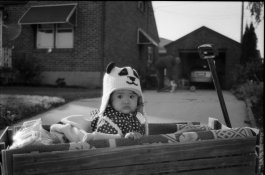Working on the assumption you have reached a rotary developing technique with your chosen film and full strength developer that works well for you, you really need to do some empirical experimenting to adjust your developing times to suit, so that with your diluted developer you end up with negatives as close as possible to your original negative.
Kodak haven’t published 1:1 dilution times for rotary processing for undisclosed reasons. I do however suspect this is mainly because in many instances, 1:1 dilution in rotary processing could often mean not enough chemicals are generally present with the sometimes miniscule amount of fluid that will just cover the film when being rotary processed.
The miniscule amount of solution one can use for developing by employing a rotary technique, as opposed to an inversion technique, can throw up some interesting differences. One thing I have noticed about rotary technique is that there is a very slight end product difference, no matter what the dilution sameness is.
Meaning, if you use inversion processing with straight undiluted developer, then develop another roll of film exposed as near as possibly identical to the first roll of inversion processed film, but process it in a rotary situation with the same amount of chemistry, you will notice a slight difference.
I did this a million years ago, shortly after getting my first rotary processing machine (Jobo CPE2) around 1986. Basically, I used 500ml of undiluted solution for inversion processing in a Jobo 1520 tank. Then, using the larger Jobo 1540 tank I developed the same amount of film using 500ml of undiluted developer but rotary processed.
There was a difference in the negatives, even looking on the light box with a naked eye it was obvious if one looked. Not much of a difference, but it was there.
What this means is you will need to do some guessing and developing tests, to find what works for your particular film that has been exposed in your particular camera(s). I’m sorry to say that there isn’t any magic bullet.
With my own rotary processing, I almost exclusively use D76 1:1, and have done so since the late eighties. Apart from a few hundred sheets of 4x5” TMax I have hardly ever used Kodak films for personal use. What I can say, is that it is possible to get extremely good and very easy to print negatives, using rotary processing with D76 at 1:1 dilution at 20ºC through to 24ºC.
My general experience with rotary processing, compared to inversion processing, is that with all things being equal, rotary processing usually requires a slightly longer time. How much extra time is hard to define, pretty much every batch of film is developed in a different batch of developer and often at different temperatures and/or dilutions.
To greatly help with consistency, one aspect of my Jobo CPE2 that is invaluable and something I picked up when developing lots of E6 film, is this. I would mix up all of the chemicals and place everything in the tempering bath, then I would load four rolls of 135 film into the 1540 tank, then go to work. About two hours before coming home I would telephone the missus and ask her to go to the darkroom and switch the Jobo on. Upon arriving home I would switch the rotation on, to more evenly warm the films up. About 15 minutes later, I would start developing my films. To put it mildly, the consistency possible using one shot E6 developing and this warm-up regime was incredible. To this day, I still allow my chemistry and films to reside in the tempering bath for quite a time, therefore allowing temperature stability to be as good as possible.
I would suggest you could do worse than expose a whole roll (or rolls) of film to a standard test chart, which includes a grey scale as well as colour patches. Then clip develop small sections of film in your rotary processing system using diluted developer. Start by doing a clip test at your standard inversion time, then subsequent clips at increasingly longer times. You should find a time that is workable for your system in a very short and relatively inexpensive manner using either this method, or something similar.
A clip test, is where you clip a small section of film from the roll and develop that on its own. I generally clip about a hand span length of film because it is easy to measure in total darkness. With this length of film and using 135 film I am guaranteed to get at least one full frame of film developed.












